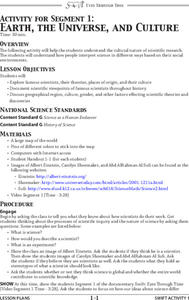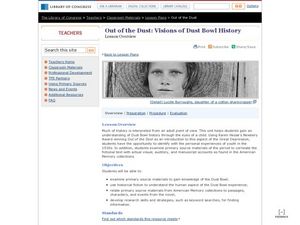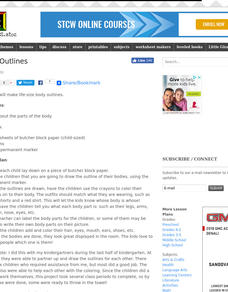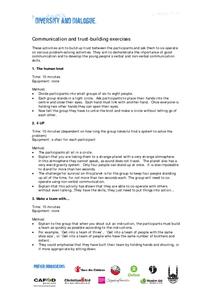Curated OER
The Holocaust in Art, Photography and Writing
Students explore paintings, photographs and writings about the Holocaust using the internet. Researching the various websites, they will discover different human experiences of Holocaust victims. After researching, students write about...
Curated OER
Asteroids!
Middle schoolers explore how to visually identify asteroids in SDSS images. They are able to explain that stars are so far away that they do not appear to move, even over the course of a human lifespan. Students identify the location...
Curated OER
The Effects of Alcohol and other Teratogens: A model using Zebrafish
Students investigate the interference of various drugs on an embryo through experimentation. This is an open-ended lab to allow students to see effects of various chemicals humans choose to put in their bodies and create questions they...
Curated OER
Seeing the Seafloor Using Sound - Multibeam Sidescan Sonar
Students are told that sound is not just stuff that our ears hear. They are explained that it is a tool for measuring and looking at objects in a new way. Students are introduced to sound waves and sonar imaging. They are explained...
Curated OER
Taste, Smell, Touch
Students explore the senses, taste, touch and smell. In this lesson about senses, students perform experiments, or activities. Students complete three activities in order to become more familiar with the three senses of taste, touch, and...
Curated OER
Body Parts
In this interactive human biology worksheet, students read ten riddles about body parts and type in the appropriate name of the body part the riddle is describing. Students also answer a nine word crossword puzzle that focuses on the...
Curated OER
My Senses Tell Me...
Students explore how to use their sense to draw conclusions. In this human biology lesson, students use their senses to observe various objects in learning centers. The centers include tasting salt, touching sandpaper, hearing bells...
Curated OER
Earth, the Universe, and Culture
Students view segment of documentary, Swift: Eyes Through Time, explore famous scientists, their theories, places of origin, and culture, document scientific viewpoints of famous scientists throughout history, and discuss geographical...
Curated OER
Out of the Dust: Visions of Dust Bowl History Lesson Overview
Students complete activities with the book Out of the Dust by Karen Hesse. In this literature lesson plan, students read this story and view the Dust Bowl history from the eyes of a child. They discover the Great Depression and life...
Curated OER
Fresh Produce North of 60
Teen-agers discuss how fresh produce is brought into areas that do not have agreeable growing conditions and read an article from Canadian Agriculture at a Glance. They write an essay about projects that may help provide food in these...
Curated OER
Body Outlines
Students trace their bodies onto butcherblock paper and then add clothes, hair, eyes, mouths, etc. They use them to identify their body parts.
Curated OER
Privacy and the Fourth Amendment
Students examine the right of privacy for individuals in a society that is changing due to technology. They examine how courts have to change the idea of privacy.
Novelinks
The Cay: Biopoem
Theodore Taylor's The Cay provides the text for an assignment that asks each reader to craft a biopoem for one of the characters.
Curated OER
Insect Anatomy
Break down insect anatomy with this worksheet! Class members diagram insect anatomy by drawing a line from the names of grasshopper body parts to the corresponding parts on an image of a grasshopper. The worksheet provides the word bank...
Diversity and Dialogue
Communication and Trust-Building Exercises
Help learners build trust and develop verbal and non-verbal communication skills with a variety of interactive activities outlined in this resource.
TED-Ed
A Brief History of Religion in Art
Did you know that some languages have no word for art? The English language does and the narrator of this short video discusses the aesthetic dimension of religious art as it "visually communicates meaning beyond language."
Messenger Education
Star Power! Discovering the Power of Sunlight
It takes less than 10 minutes for energy from the sun to travel 90 million miles to Earth! In the first installment in a series of four, groups measure the amount of solar radiation that reaches Earth. They then discuss how this is...
ProCon
Gold Standard
If all the mined gold in the world was melted across a football field, it would rise 5.4 feet. That's just one interesting fact pupils learn when using the debate topics website to determine if the United States should return to a gold...
American Museum of Natural History
Bacteria in the Cafeteria
Scholars examine an animated picture to locate stars that, when chosen, provide a brief scenario, question, and answer. With each answer, a letter appears that later reveals a word.
National Endowment for the Humanities
The Rise and Fall of Joseph McCarthy
"I have here in my hand . . ." The war against Communism and Joseph McCarthy’s place in it are the focus of a series of lessons examining postwar America from 1945-1954. Joseph McCarthy takes center stage in this, the final lesson...
Curated OER
Rainy Day? P.E. Anyway!
If your PE class is faced with bad weather and must stay indoors, try one of these activities to keep them engaged and moving! Activities involve working in teams, identifying sports or parts of the body, coordination practice, and/or...
US Institute of Peace
What Does It Take to Be a Peacebuilder?
Is the spirit of peacebuilding already inside you? Scholars take a closer look at the characteristics of peacebuilders, past and present, in lesson 13 of a 15-part series. Individuals identify common traits of peacebuilders, then work...
Curated OER
Sea Connections: Marine Ecosystems
Students identify producers and consumers from marine ecosystems and describe the balance among them in the environments. After constructing a food chain from a marine ecosystem, they examine human activities that can upset the balance...
Curated OER
You Won't Believe Your Eyes!
Students gain a basic understanding of the sense of sight. They watch a video on sight, then engage in some vocabulary games, and perform some simple experiments which focus on the basics of sight.























